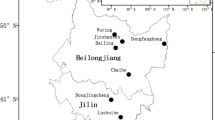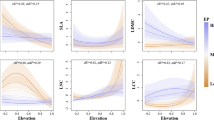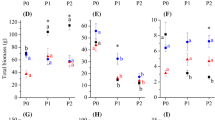Abstract
Exploring plant trait variance within a species that is naturally distributed along an environmental gradient is key to understanding plant acclimation strategies. Here, we investigated plant trait variance of Sophora moorcroftiana in the Qinghai–Tibet Plateau along an altitudinal gradient. The results showed that plant traits changed from acquisitive to conservative resource use strategy from low to high altitudes. Site-specific trait variance increased along with altitude increase and was strongly correlated with temperature variables, especially closely correlated with minimum temperature in the coldest month. The decreased trends of acquisitive traits and the increase of site-specific trait variance were coordinated with increased S. moorcroftiana dominance in high altitudes. The findings provided insight that the combination of plant resource use strategy and site-specific trait variance contributes to S. moorcroftiana dominance in response to divergent environmental conditions along altitudinal gradients. The strong correlation between plant trait variance and the minimum temperature in the coldest month suggested that it should pay more attention to the critical role extreme temperature played on trait variance which was often neglected in the past.







Similar content being viewed by others
References
Aerts R, Chapin FSI (2000) The mineral nutrition of wild plants revisited: a reevaluation of processes and patterns. Adv Ecol Res 30:1–67
Agurla S, Gahir S, Munemasa S, Murata Y, Raghavendra AS (2018) Mechanism of stomatal closure in plants exposed to drought and cold stress. Survival strategies in extreme cold and desiccation. Adv Exp Med Biol 1081:215–232
Akram H, Pasaribu N, Siregar ES (2019) Tree species diversity, richness and similarity in disturbed and undisturbed forest of Ketambe Research Station, Southeast Aceh regency. IOP Conf Ser Earth Environ Sci 305:012094
Blanquart F, Kaltz O, Nuismer SL, Gandon S (2013) A practical guide to measuring local adaptation. Ecol Lett 16:1195–1205
Bricca A, Carranza ML, Varricchione M, Cutini M, Stanisci A (2021) Exploring plant functional diversity and redundancy of Mediterranean high-mountain habitats in the Apennines. Diversity-Basel 13:466
Buckley TN, Roberts DW (2006) How should leaf area, sapwood area and stomatal conductance vary with tree height to maximize growth? Tree Physiol 26:145–157
Camarero JJ, Gutierrez E (2017) Wood density of silver fir reflects drought and cold stress across climatic and biogeographic gradients. Dendrochronologia 45:101–112
Cheng SM, Qiong L, Lu F, Yonezawa T, Yin GQ, Song ZP et al (2017) Phylogeography of Sophora moorcroftiana supports Wu’s hypothesis on the origin of Tibetan alpine flora. J Hered 108:405–414
Chinese Academy of Sciences (1985) Flora of Tibet. China Science Publishing & Media Ltd, Beijing
Chown SL, Gaston KJ, Robinson D (2004) Macrophysiology: large-scale patterns in physiological traits and their ecological implications. Funct Ecol 18:159–167
Cornwell WK, Bhaskar R, Sack L, Cordell S, Lunch CK (2007) Adjustment of structure and function of Hawaiian Metrosideros polymorpha at high vs. low precipitation. Funct Ecol 21:1063–1071
Cui GS, Zhang L, Shen W, Liu XS, Wang YT (2017) Biomass allocation and carbon density of Sophora moorcroftiana shrublands in the middle reaches of Yarlung Zangbo River, Xizang, China. Chin J Plant Ecol 41:53–61
Cusser S, Helms J, Bahlai CA, Haddad NM (2021) How long do population level field experiments need to be? Utilising data from the 40-year-old LTER network. Ecol Lett 24:1103–1111
Daehler CC (2003) Performance comparisons of co-occurring native and alien invasive plants: implications for conservation and restoration. Annu Rev Ecol Evol Syst 34:183–211
Davidson AM, Jennions M, Nicotra AB (2011) Do invasive species show higher phenotypic plasticity than native species and if so, is it adaptive? A meta-analysis. Ecol Lett 14:419–431
Erofeeva EA (2021) Plant hormesis and Shelford’s tolerance law curve. J Forest Res 32:1789–1802
Everitt B (1998) The Cambridge dictionary of statistics. Cambridge University Press, Cambridge
Feng, X.Y., Lin, P.F. & Zhao, W.Z. (2022). The physiological constraints of alpine treeline in Qilian Mountains. Forest Ecol Manag, 503.
Fick SE, Hijmans RJ (2017) WorldClim 2: new 1-km spatial resolution climate surfaces for global land areas. Int J Climatol 37:4302–4315
Francis EJ, Muller-Landau HC, Wright SJ, Visser MD, Iida Y, Fletcher C et al (2017) Quantifying the role of wood density in explaining interspecific variation in growth of tropical trees. Global Ecol Biogeogr 26:1078–1087
Fu YR, Yao WJ, Li SK, Li HE (2016) Improvement of seed germination and in vitro propagation of a multipurpose plateau shrub species Sophora moorcroftiana. Pak J Bot 48:1439–1445
Gianoli E (2004) Plasticity of traits and correlations in two populations of Convolvulus arvensis (Convolvulaceae) differing in environmental heterogeneity. Int J Plant Sci 165:825–832
Gimeno TE, Pias B, Lemos JP, Valladares F (2009) Plasticity and stress tolerance override local adaptation in the responses of Mediterranean holm oak seedlings to drought and cold. Tree Physiol 29:87–98
Graae BJ, De Frenne P, Kolb A, Brunet J, Chabrerie O, Verheyen K et al (2012) On the use of weather data in ecological studies along altitudinal and latitudinal gradients. Oikos 121:3–19
Grytnes JA, Kapfer J, Jurasinski G, Birks HH, Henriksen H, Klanderud K et al (2014) Identifying the driving factors behind observed elevational range shifts on European mountains. Global Ecol Biogeogr 23:876–884
Hajihashemil S, Noedoostl F, Geuns JMC, Djalovic L, Siddique KHM (2018) Effect of cold stress on photosynthetic traits, carbohydrates, morphology, and anatomy in nine cultivars of Stevia rebaudiana. Front Plant Sci. https://doi.org/10.3389/fpls.2018.014
Halbritter AH, Fior S, Keller I, Billeter R, Edwards PJ, Holderegger R et al (2018) Trait differentiation and adaptation of plants along elevation gradients. J Evol Biol 31:784–800
Henn JJ, Buzzard V, Enquist BJ, Halbritter AH, Klanderuds K, Maitner BS et al (2018) Intraspecific trait variation and phenotypic plasticity mediate alpine plant species response to climate change. Front Plant Sci. https://doi.org/10.3389/fpls.2018.01548
Heschel MS, Sultan SE, Glover S, Sloan D (2004) Population differentiation and plastic responses to drought stress in the generalist annual Polygonum persicaria. Int J Plant Sci 165:817–824
Hikosaka K, Ishikawa K, Borjigidai A, Muller O, Onoda Y (2006) Temperature acclimation of photosynthesis: mechanisms involved in the changes in temperature dependence of photosynthetic rate. J Exp Bot 57:291–302
IPCC (2022) Climate change 2022: impacts, adaptation, and vulnerability. Cambridge University Press, Cambridge/New York
Jump AS, Matyas C, Penuelas J (2009) The altitude-for-latitude disparity in the range retractions of woody species. Trends Ecol Evol 24:694–701
Kent M (2011) Vegetation description and data analysis: a practical approach, 2nd edn. Wiley-Blackwell, Oxford
Kim E, Donohue K (2013) Local adaptation and plasticity of Erysimum capitatum to altitude: its implications for responses to climate change. J Ecol 101:796–805
Körner C (2007) The use of ‘altitude’ in ecological research. Trends Ecol Evol 22:569–574
Korner C, Paulsen J (2004) A world-wide study of high altitude treeline temperatures. J Biogeogr 31:713–732
Körner C (2016) Plant adaptation to cold climates. F1000Research 5:2769
Kraft NJB, Godoy O, Levine JM (2015) Plant functional traits and the multidimensional nature of species coexistence. Proc Natl Acad Sci USA 112:797–802
Kumarathunge DP, Medlyn BE, Drake JE, Tjoelker MG, Aspinwall MJ, Battaglia M et al (2019) Acclimation and adaptation components of the temperature dependence of plant photosynthesis at the global scale. New Phytol 222:768–784
Lapenis A, Shvidenko A, Shepaschenko D, Nilsson S, Aiyyer A (2005) Acclimation of Russian forests to recent changes in climate. Global Change Biol 11:2090–2102
Lavorel S, Garnier E (2002) Predicting changes in community composition and ecosystem functioning from plant traits: revisiting the Holy Grail. Funct Ecol 16:545–556
Lazaro-Nogal A, Matesanz S, Godoy A, Perez-Trautman F, Gianoli E, Valladares F (2015) Environmental heterogeneity leads to higher plasticity in dry-edge populations of a semi-arid Chilean shrub: insights into climate change responses. J Ecol 103:338–350
Lee J, Wong DW (2001) Statistical analysis with ArcView GIS. Wiley, New York
Li W (2019) Analysis on dynamic changes of sandy desertification land in the middle and upper reaches of Yarlung Zangbo river in Tibet. MA thesis, Tibet University
Lin L, Ye YH, Luo J, Chen S, Wang JH (2014) Seed germination of different provenances of Sophora moorcroftiana, an endemic species to the Qinghai–Tibetan Plateau. For Res 24:508–513
Liu ZM, Zhao AM, Kang XY, Zhou SL, Lopez-Pujol J (2006) Genetic diversity, population structure, and conservation of Sophora moorcroftiana (Fabaceae), a shrub endemic to the Tibetan Plateau. Plant Biol 8:81–92
Liu B, Ma WJ, Wang JH, Pubu CR, Xiang Y (2017) Drought-resistance of Sophora moorcroftiana from different population from leaf anatomical structure. Bull Botan Res 37:325–333
Liu H, Gleason SM, Hao GY, Hua L, He PC, Goldstein G et al (2019) Hydraulic traits are coordinated with maximum plant height at the global scale. Sci Adv. https://doi.org/10.1126/sciadv.aav1332
Liu Y, Yi F, Yang GJ, Wang YT, Pubu C, He RH et al (2020) Geographic population genetic structure and diversity of Sophora moorcroftiana based on genotyping-by-sequencing (GBS). PeerJ 8:e960
Liu ZG, Dong N, Zhang HX, Zhao M, Ren TT, Liu CC et al (2021) Divergent long- and short-term responses to environmental gradients in specific leaf area of grassland species. Ecol Indic 130:108058
Ludwig F, Rosenthal DM, Johnston JA, Kane N, Gross BL, Lexer C et al (2004) Selection on leaf ecophysiological traits in a desert hybrid Helianthus species and early-generation hybrids. Evolution 58:2682–2692
Maharjan SK, Sterck FJ, Dhakal BP, Makri M, Poorter L (2021) Functional traits shape tree species distribution in the Himalayas. J Ecol 109:3818–3834
Mao LF, Chen SB, Zhang JL, Zhou GS (2018) Altitudinal patterns of maximum plant height on the Tibetan Plateau. J Plant Ecol 11:85–91
Matesanz S, Ramirez-Valiente JA (2019) A review and meta-analysis of intraspecific differences in phenotypic plasticity: implications to forecast plant responses to climate change. Global Ecol Biogeogr 28:1682–1694
Matias L, Godoy O, Gomez-Aparicio L, Perez-Ramos IM (2018) An experimental extreme drought reduces the likelihood of species to coexist despite increasing intransitivity in competitive networks. J Ecol 106:826–837
Mediavilla S, Garcia-Ciudad A, Garcia-Criado B, Escudero A (2008) Testing the correlations between leaf life span and leaf structural reinforcement in 13 species of European Mediterranean woody plants. Funct Ecol 22:787–793
Mencuccini M, Rosa T, Rowland L, Choat B, Cornelissen H, Jansen S et al (2019) Leaf economics and plant hydraulics drive leaf : wood area ratios. New Phytol 224:1544–1556
Midolo G, De Frenne P, Holzel N, Wellstein C (2019) Global patterns of intraspecific leaf trait responses to elevation. Global Change Biol 25:2485–2498
Missanjo E, Matsumura J (2016) Wood density and mechanical properties of Pinus kesiya Royle ex Gordon in Malawi. Forests 7:135
Onoda Y, Anten NP (2011) Challenges to understand plant responses to wind. Plant Signal Behav 6:1057–1059
Perez-Harguindeguy N, Diaz S, Garnier E, Lavorel S, Poorter H, Jaureguiberry P et al (2013) New handbook for standardised measurement of plant functional traits worldwide. Aust J Bot 61:167–234
Perez-Ramos IM, Roumet C, Cruz P, Blanchard A, Autran P, Garnier E (2012) Evidence for a ‘plant community economics spectrum’ driven by nutrient and water limitations in a Mediterranean rangeland of southern France. J Ecol 100:1315–1327
Perez-Ramos IM, Matias L, Gomez-Aparicio L, Godoy O (2019) Functional traits and phenotypic plasticity modulate species coexistence across contrasting climatic conditions. Nat Commun. https://doi.org/10.1038/s41467-019-10453-0
Pfennigwerth AA, Bailey JK, Schweitzer JA (2017) Trait variation along elevation gradients in a dominant woody shrub is population-specific and driven by plasticity. Aob Plants. https://doi.org/10.1093/aobpla/plx027
Qin HJ, Jiao L, Zhou Y, Wu JJ, Che XC (2022) Elevation affects the ecological stoichiometry of Qinghai spruce in the Qilian Mountains of northwest China. Front Plant Sci. https://doi.org/10.3389/fpls.2022
R Core Team (2022) R: a language and environment for statistical computing. R Foundation for Statistical Computing, Vienna
Rathore N, Thakur D, Chawla A (2018) Seasonal variations coupled with elevation gradient drives significant changes in eco-physiological and biogeochemical traits of a high altitude evergreen broadleaf shrub, Rhododendron anthopogon. Plant Physiol Biochem 132:708–719
Read QD, Moorhead LC, Swenson NG, Bailey JK, Sanders NJ (2014) Convergent effects of elevation on functional leaf traits within and among species. Funct Ecol 28:37–45
Rolhauser AG, Pucheta E (2017) Directional, stabilizing, and disruptive trait selection as alternative mechanisms for plant community assembly. Ecology 98:668–677
Togashi HF, Prentice IC, Evans BJ, Forrester DI, Drake P, Feikema P et al (2015) Morphological and moisture availability controls of the leaf area-to-sapwood area ratio: analysis of measurements on Australian trees. Ecol Evol 5:1263–1270
Topaloglu E, Ay N, Altun L, Serdar B (2016) Effect of altitude and aspect on various wood properties of Oriental beech (Fagus orientalis Lipsky) wood. Turk J Agric for 40:397–406
Turunen M, Latola K (2005) UV-B radiation and acclimation in timberline plants. Environ Pollut 137:390–403
Valladares F, Gianoli E, Gomez JM (2007) Ecological limits to plant phenotypic plasticity. New Phytol 176:749–763
van der Sande MT, Poorter L, Schnitzer SA, Engelbrecht BMJ, Markesteijn L (2019) The hydraulic efficiency-safety trade-off differs between lianas and trees. Ecology. https://doi.org/10.1002/ecy.2666
van Kleunen M, Fischer M (2005) Constraints on the evolution of adaptive phenotypic plasticity in plants. New Phytol 166:49–60
Wadgymar SM, Ogilvie JE, Inouye DW, Weis AE, Anderson JT (2018) Phenological responses to multiple environmental drivers under climate change: insights from a long-term observational study and a manipulative field experiment. New Phytol 218:517–529
Wainwright CE, HilleRisLambers J, Lai HR, Loy X, Mayfield MM (2019) Distinct responses of niche and fitness differences to water availability underlie variable coexistence outcomes in semi-arid annual plant communities. J Ecol 107:293–306
Xie JB, Wang ZY, Li Y (2022) Stomatal opening ratio mediates trait coordinating network adaptation to environmental gradients. New Phytol 235:907–922
Xin FM, Liu JM, Chang C, Wang YT, Jia LM (2021) Evaluating the influence of climate change on Sophora moorcroftiana (Benth.) Baker habitat distribution on the Tibetan Plateau using maximum entropy model. Forests 12:1230
Yuan RY, Dongzhi ZM, Guo W, Zhen P, Liu ZM, Huang S et al (2022) Hepatoprotective effect of Sophora moorcroftiana (Benth.) Benth. Ex baker seeds in vivo and in vitro. Drug Chem Toxicol 45:2535–2544
Zhao WZ, Zhang ZH, Li QY (2007) Growth and reproduction of Sophora moorcroftiana responding to altitude and sand burial in the middle Tibet. Environ Geol 53:11–17
Zhao Y, Duan S, Zheng Y, Nan J, Mi S, Zhao Y et al (2019) Seedling growth and photosynthetic characteristics of different. J Zhejiang Univ (agric Life Sci) 45:164–174
Acknowledgements
The authors thank the support from the Key Research Program of Frontier Sciences, CAS (Grant No. QYZDJ-SSW-DQC040), and the National Natural Science Foundation of China (Grant No. 32171876/52172300).
Funding
Funding was provided by Key Research Program of Frontier Sciences, CAS (Grant no. QYZDJ-SSW-DQC040) and National Natural Science Foundation of China (Grant nos. 52172300 and 32171876).
Author information
Authors and Affiliations
Contributions
ZW and FX designed the field experiment. FX, ZL, and WC conducted the field survey and measured the plant traits. FX, ZH, YQ, and WC prepared the figures and tables of the manuscript. FX and ZW wrote and reviewed the manuscript.
Corresponding author
Ethics declarations
Conflict of interest
The authors declare that they have no known competing financial interests or personal relationships that could have appeared to influence the work reported in this paper.
Additional information
Communicated by Wenzhi Zhao.
Publisher's Note
Springer Nature remains neutral with regard to jurisdictional claims in published maps and institutional affiliations.
Supplementary Information
Below is the link to the electronic supplementary material.
Rights and permissions
Springer Nature or its licensor (e.g. a society or other partner) holds exclusive rights to this article under a publishing agreement with the author(s) or other rightsholder(s); author self-archiving of the accepted manuscript version of this article is solely governed by the terms of such publishing agreement and applicable law.
About this article
Cite this article
Feng, X., Zhong, L., Wang, C. et al. Acquisitive to conservative resource use strategy and increased site-specific trait variance contribute to Sophora moorcroftiana dominance along an altitudinal gradient in Qinghai–Tibet Plateau. Plant Ecol 224, 1075–1087 (2023). https://doi.org/10.1007/s11258-023-01362-w
Received:
Accepted:
Published:
Issue Date:
DOI: https://doi.org/10.1007/s11258-023-01362-w




